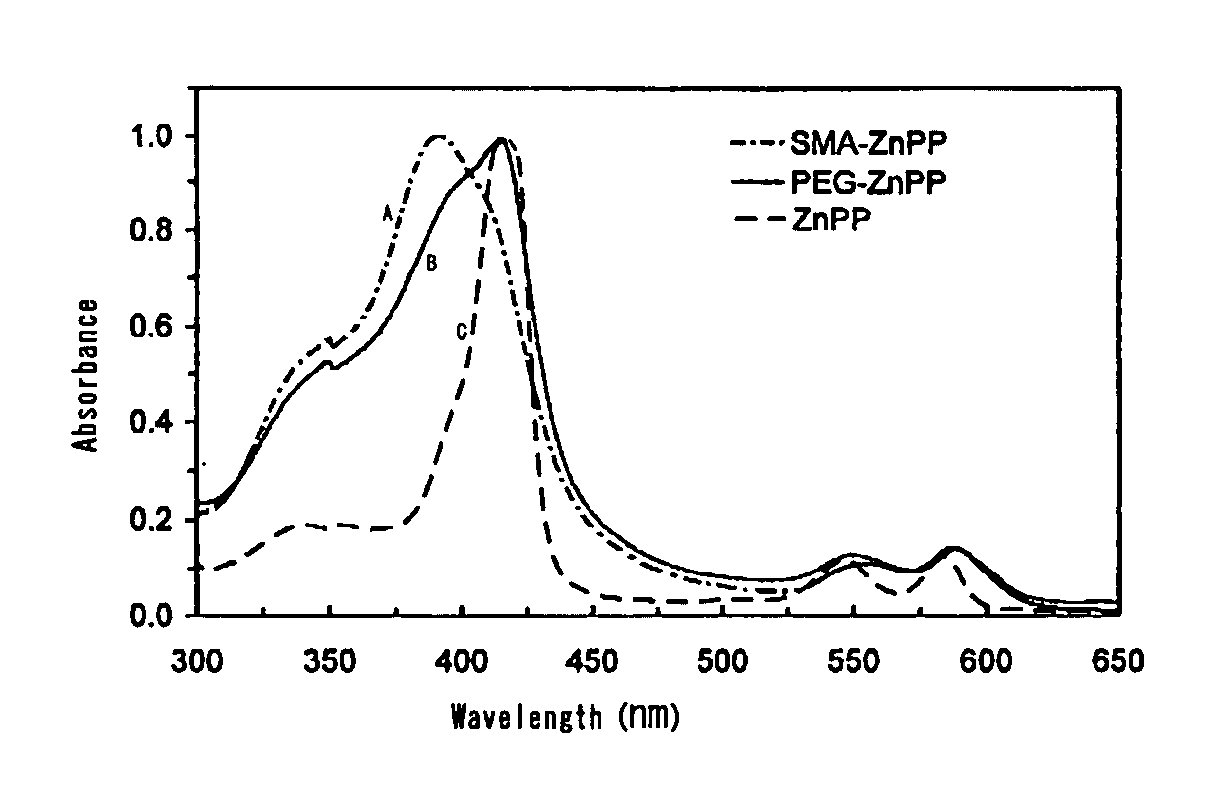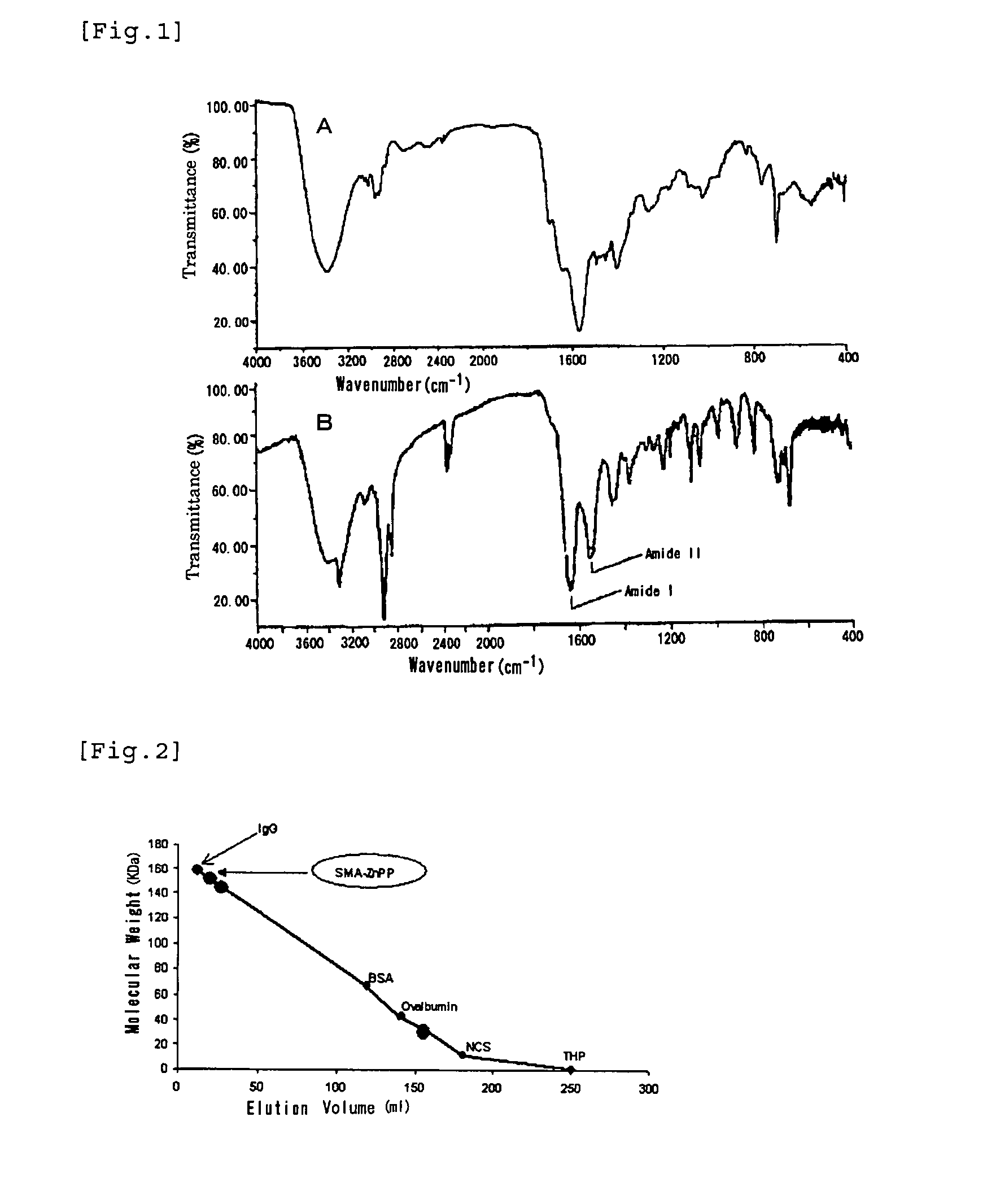Polymeric pharmaceutical agent for treatment of cancer and method for production of the same
a cancer and polymer technology, applied in the direction of powder delivery, chemical/physical process, drug composition, etc., can solve the problems of suppressing the dosage of such a potent drug, not sufficiently showing the effect, and affecting the normal organs and tissues other than lesions with severe side effects, etc., to achieve superior anti-tumor effect, increase molecular weight, and less side effects
- Summary
- Abstract
- Description
- Claims
- Application Information
AI Technical Summary
Benefits of technology
Problems solved by technology
Method used
Image
Examples
example 1
Process for Producing SMA-ZnPP Micelles
[0058]200 mL of 0.1 M NaOH is added to 1.5 g of styrene / maleic anhydride copolymer having an average molecular weight of about 1,500 to bring to pH 13, and the mixture is stirred by a magnetic stirrer. While stirring, 1.5 g of finely powdered zinc (Zn)-protoporphyrin is added and continuously stirred. In the course of time, the turbid suspension becomes a dark wine-red clear solution. Insoluble ZnPP and other residues are removed by centrifugation (3,000 rpm) and the pH is lowered to around 7, and this solution is mixed with about 3 volumes of 10 mM Na2CO3 / NaHCO3 solution and stirred continuously. After 2 hours, the mixture is supplied with an appropriate amount of 0.1M HCl to adjust the pH to about 7, and stirred continuously for another 2 hours. Next, the solution was concentrated to 50 mL under pressure using an ultrafiltration membrane with a molecular cutoff size of 3,000 (Amicon Inc.). By this procedure free ZnPP, or non-micelled SMA or d...
example 2
Production of SMA-Hemin Micelle
[0069]50 ml of deionized water is added to 300 mg of completely alkali-hydrolyzed SMA placed in a 200 ml beaker, and the mixture is dissolved under stirring by a magnetic stirrer, and then 0.1 M NaOH is added dropwise to adjust the pH to 10. 100 mg of Hemin (Sigma Inc.) is dissolved in 4 ml of DMSO (dimethylsulfoxide) in a 20 ml glass vial, and this solution is added dropwise in the aforementioned beaker under stirring to mix. Then, 1 M NaOH is added dropwise to lift the pH up to 12, and the mixture is stirred for 15 minutes and then supplied dropwise with 1 M HCl to bring the pH down to 2. The mixture turns to a dark brown suspension, and is stirred continuously for 30-60 minutes to dissolve. Next, the precipitates and supernatant are separated by centrifugation (3000-6000 rpm), and further 30 ml of 0.02 M acetic acid solution is added, and after stirring again (30 minutes), 0.1 M NaOH is added dropwise to this aqueous suspension of SMA-micelles to li...
PUM
| Property | Measurement | Unit |
|---|---|---|
| pH | aaaaa | aaaaa |
| pH | aaaaa | aaaaa |
| wavelength | aaaaa | aaaaa |
Abstract
Description
Claims
Application Information
 Login to View More
Login to View More - R&D Engineer
- R&D Manager
- IP Professional
- Industry Leading Data Capabilities
- Powerful AI technology
- Patent DNA Extraction
Browse by: Latest US Patents, China's latest patents, Technical Efficacy Thesaurus, Application Domain, Technology Topic, Popular Technical Reports.
© 2024 PatSnap. All rights reserved.Legal|Privacy policy|Modern Slavery Act Transparency Statement|Sitemap|About US| Contact US: help@patsnap.com










